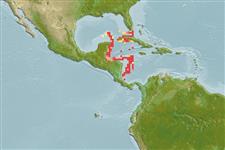Common names from other countries
>
Ophidiiformes (Cusk eels) >
Ophidiidae (Cusk-eels) > Ophidiinae
Etymology: Lepophidium: Latin, lepus, leporis = rabbit + Greek, ophis = serpent (Ref. 45335).
More on author: Robins.
Environment: milieu / climate zone / depth range / distribution range
Ecologia
marinhas batidemersal; intervalo de profundidade 180 - 485 m (Ref. 34024). Deep-water; 25°N - 10°N, 90°W - 80°W (Ref. 91765)
Western Atlantic: apparently restricted to the deep bank area east and northeast of Nicaragua and Honduras in the western Caribbean Sea and north of the Yucatan Peninsula in the southern Gulf of Mexico; not in the eastern Gulf of Mexico.
Tamanho / Peso / Idade
Maturity: Lm ? range ? - ? cm
Max length : 27.3 cm SL macho/indeterminado; (Ref. 91765)
Descrição suscinta
Chaves de identificação | Morfologia | Morfometria
Raios dorsais (total) : 140 - 147; Raios anais : 120 - 125; Vértebras: 80 - 83. This species is characterized by the following: usual number of vertebrae, precaudal 14-15, caudal 65-67, total 81-82 (80-83); usual number of fin rays, dorsal 142-145 (140-147), anal 120-125, pectoral 22-23); pyloric caeca usually 3 (rarely 4), 2 (rarely 3) in a single whorl, 1 in 2nd tier; first gill arch with rudimentary rakers 4 (rarely 3) on the upper arm, 8 developed (rarely 7) developed rakers on the lower limb, 0-3 (usually 0) rudimentary rakers anteriorly on the first arch; total rakers 12 (usually 11-14); dorsal-fin origin between neural spines 4-5 (11 specimens) or 5-6 (6 specimens) (Ref. 91765).
Rare species (Ref. 34024). Reproductive strategy possibly similar to other members of this family featuring oviparity, with oval pelagic eggs floating in a gelatinous mass (Ref. 205).
Ciclo de vida ou comportamento de acasalamento
Maturities | Reprodução | Spawnings | Egg(s) | Fecundities | Larvas
Robins, C.R., R.H. Robins and M.E. Brown, 2012. A revision of Lepophidium (Teleoastei, Ophidiidae), with descriptions of eight new species. Bulletin of the Florida Museum of Natural History 52(1):1-94. (Ref. 91765)
Status na Lista Vermelha da UICN (Ref. 130435)
CITES (Ref. 128078)
Not Evaluated
Ameaça para os humanos
Harmless
Uso pelos humanos
Ferramentas
Relatórios especiais
Baixar XML
Fontes da internet
Estimates based on models
Preferred temperature (Ref.
115969): 13.8 - 20.6, mean 17.7 (based on 7 cells).
Índice de diversidade filogenética (Ref.
82804): PD
50 = 0.5000 [Uniqueness, from 0.5 = low to 2.0 = high].
Bayesian length-weight: a=0.00102 (0.00046 - 0.00225), b=3.06 (2.88 - 3.24), in cm Total Length, based on all LWR estimates for this body shape (Ref.
93245).
Nível Trófico (Ref.
69278): 3.6 ±0.7 se; based on size and trophs of closest relatives
Resiliência (Ref.
120179): médio(a), tempo mínimo de duplicação da população 1,4 - 4,4 anos (Assuming tmax>3).
Fishing Vulnerability (Ref.
59153): Low vulnerability (23 of 100).
